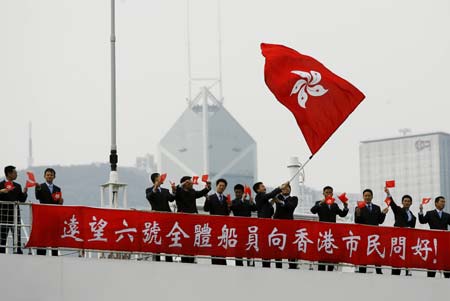The Chinese mainland's space-tracking ship Yuanwang VI arrived in Hong Kong on Wednesday for a six-day visit.
 |
|
Crew members wave the flag of Hong Kong Special Administrative Region as China's space-tracking ship "Yuanwang VI" arrives in Hong Kong, south China, on April 29, 2009. "Yuanwang VI" arrived in Hong Kong on Wednesday for a six-day visit, kicking off a string of activities in the special administrative region to celebrate the 60th anniversary of the founding of the People's Republic of China, which falls on Oct. 1.
|
The visit kicked off a string of activities in the special administrative region to celebrate the 60th anniversary of the founding of the People's Republic of China.
At about 9:45 a.m., the ship sailed toward the Ocean Terminal, Tsim Sha Tsui. A hundred local primary school students at the pier waved national flags and regional flags to welcome the ship.
Representing the Hong Kong government and members of the public, the city's Chief Secretary for Administration Henry Tang held a welcoming ceremony for members from the ship.
Yuanwang's Captain Ling Yuan told reporters that Yuanwang had just finished a mission at the Pacific Ocean area before coming to Hong Kong, saying he would welcome Hong Kong people on board and answer their questions.
There will be an exhibition on board running from April 29 to May 4 for the public. A free public lecture will be held on April 30 at the Science Museum of Hong Kong conducted by the ship's captain and scientists.
Construction of Yuanwang VI was completed in 2008. It represents a new generation of space-tracking ships designed and manufactured in the Chinese mainland. On its maiden voyage last September, Yuanwang VI was engaged in maritime tracking of the Shenzhou VII manned space mission.
In all, China boasts a fleet of six Yuanwang space tracking ships which have carried out some 70 expeditions and traveled more than 1.5 million sea miles in the Pacific, Atlantic and Indian oceans.
The tracking ships constitute China's space telemetry network together with some 20 terrestrial surveying stations.